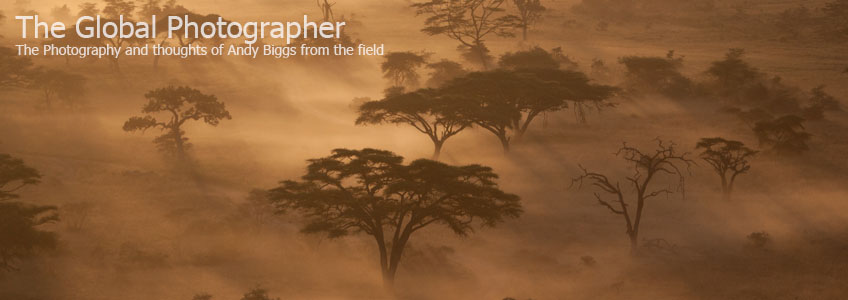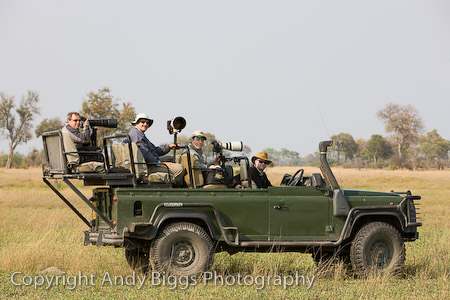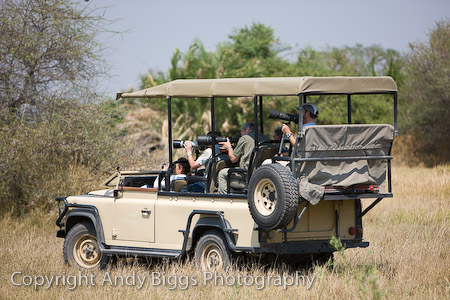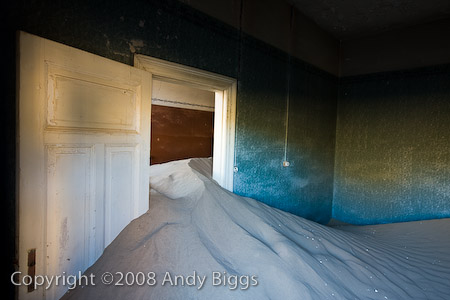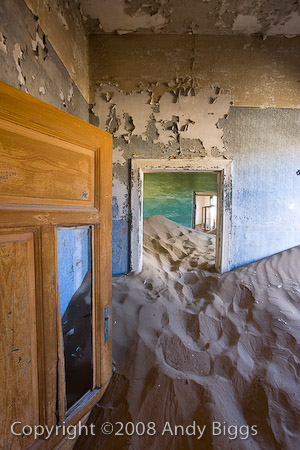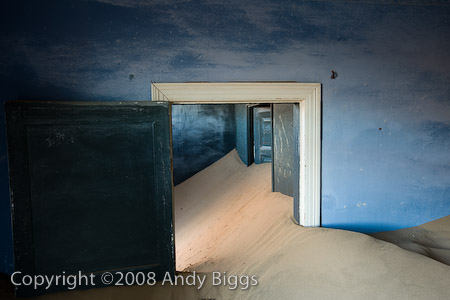Namibia: What worked and what did not
 Tuesday, September 30, 2008 at 11:50AM
Tuesday, September 30, 2008 at 11:50AM Now that I am home and settled, I am looking back at my past two safaris in Namibia and Botswana and I have some thoughts about what worked and what did not. This entry will only relate to my Namibia safari, and I will post a separate entry that is specific to my Botswana safari.
Since my Namibia safari was followed by a wildlife-only safari in Botswana, many of my equipment choices were skewed in favor of shooting wildlife instead of landscapes. Our Namibia safari had three different locations, and here they are with the primary subjects:
- Kolmanskop ghost town: deserted mining town with sand in and around the buildings
- Namib-Naukluft Park: tallest sand dunes in the world
- Ongava / Etosha: desert wildlife
- Canon 1DsMkIII (x2)
- 16-35mm f/2.8 L
- 24-105mm f/4 L IS
- 70-200mm f/2.8 L IS
- 400mm f/4 DO IS
- 1.4x teleconverter
- Gitzo GT3540LS tripod and RRS BH-55 ballhead
- 116GB of CF cards
All of this gear was packed inside a Gura Gear Kiboko camera bag for international travel, as well as use in the field. Yes, I know I have mentioned Gura Gear in the past (just a few times), and we will be launching the site very very soon. The final touches are being worked on this week. For those shoots when I only needed 1 camera and 2 lenses, I chose my Mountainsmith Tour waist bag with Domke padded inserts. This worked extremely well, but so would a photo vest or belt system. Now I will break down each of the locations with what gear was used and what I will do differently next time.
Kolmanskop
My primary method for shooting at Kolmanskop was to have a camera and a lens mounted on a tripod, carried over my shoulder, with a second lens, filters, water bottle and extra CF cards in my Mountainsmith Tour bag. This worked extremely well on my last trip to Namibia in 2006, and it did not disappoint this time around. Kolmanskop is a deserted mining town where the primary photographic subjects are the interiors of the dwellings with tons of sand inside. My primary lens was the 16-35mm, but switched out with the 24-105mm quite often.

Kolmanskop, Namibia. September 2008
Canon 1DsMkIII, 16-35mm f/2.8 L
Namib-Naukluft Park
The Namib desert at Sossusvlei and Deadvlei tend to vary from subjects that are close to the camera (the dead trees at Deadvlei) and subjects that are far away from the camera (the tall sand dunes at Sossusvlei and the rest of the park). For this reason I chose to work primarily with the 70-200mm and 24-105mm lenses. The tall dunes pretty much work best with a longer lens, and I probably used the 70-200mm most of the time. Yes, I did use the 24-105mm some, but not very much. I used the 24-105mm 50% of the time and the 70-200mm the other 50% of the time at Deadvlei.

Deadvlei, Namib-Naukluft Park, Namibia. September 2008
Canon 1DsMkIII, 70-200mm f/2.8 L IS

Sossusvlei, Namib-Naukluft Park, Namibia. September 2008
Canon 1DsMkIII, 70-200mm f/2.8 L IS
Etosha and Ongava
We stayed at Ongava Tented Camp for 3 nights, which was in the middle of Ongava Game Reserve. Ongava Game Reserve borders Etosha National Park, so we could choose to stay on the reserve or head into the park on a game drive by game drive basis. My main lens for wildlife on this trip was my trusty 400mm f/4 DO IS, which tends to go with me everywhere in Africa outside of Tanzania. Why? I value the smaller and lighter lenses like the DO over larger and heavier lenses like the 500mm f/4. My primary stabilization device was a Gitzo carbon fiber monopod, which allowed me to move between each side of the vehicle easily. I was also working with an experimental support system that an equipment manufacturer and I are working on. Hopefully this item will make it to market and others can benefit from its rock-solid platform. I am not at liberty to share photos of the setup at this time, but the goal is to have a product that is versatile, lightweight, easy to pack, and modular. All of these requirements have been met, but the system as it stands right now isn't ready to bring to market.
I used the 1.4x teleconverter 50% of the time, and sometimes wished for more focal length for extremely tight shots.

Okaukuejo, Etosha National Park, Namibia. September 2008
Canon 1DsMkIII, 400mm f/4 DO IS
What worked?
I loved having two identical cameras, and I wasn't fiddling with a different layout. On my last trip to Namibia, I took a Canon 5D and a 20D. I loved the lightweight approach, but I have since abandoned non 1-series Canon cameras in favor of larger file sizes, more durability and better weather sealing. Namibia is a location that has the ability to push one's equipment to the extreme, but on this trip we didn't have as strong winds to complicate things. In 2006 I had to send in all of my lenses for repair as the result of sand getting into the focusing rings, adding up to more than $600 in total. I was smarter this time and protected my equipment much better, but we didn't have to contend with light sand storms, either.
My lens choices turned out to be perfect in all ways. If I didn't have a trip to Botswana on the heels of the Namibia portion, I would have given though to bringing a 70-200mm f/4 L IS lens. I love reducing weight when I can, and that lens would help in that regard. I am going back to Namibia next May, and will be running two landscape-only workshops, and I am likely to take some creative risks and only bring with me a panorama film camera. Namibia screams for a panorama representation, and just might go that route. For those who are joining me next May, if you own a medium format digital camera this is your best opportunity to put the gear to use!
The Gura Gear Kiboko bag is the best bag to work out of when I have more gear than just a camera and 2 lenses, and is the best bag for traveling internationally with a ton of gear. The Kiboko bag weighs only 4 pounds, and converts from a traditional backpack into a carrying bag. This means that the harness system can be stowed away when you don't want it in your way. This is a great feature when you are shooting from a safari vehicle, and the bag is sitting next to you on the seat. I can have 3 cameras mounted to lenses ready to shoot with, all ready to go and sitting in the bag. For example, a camera + 400mm, a camera + 24-105mm and a camera + 70-200mm. All ready to use, and sitting in a padded bag at my side.
On a non-photographic equipment note, I am glad that I brought along my lightweight hiking boots, as it prevented tons of sand from entering my shoes when hiking in deep sand. The high-tops worked great in this regard.
I brought along 116GB of total compact flash card memory, along with my Apple Macbook Air notebook computer and external hard drive. To be honest, I love not having to deal with the daily downloading of images. It always seems to interfere with my ability to get ready for dinner and get to the bar quickly for a nice, cold beer. I am not a heavy drinker, but I do enjoy a pre-dinner adult drink. And after dinner I am usually ready to crash for the night. When I had the time, I would copy a full CF card to my Macbook Air or external hard drive as my backup. My approach is to not overwrite a CF card at all on a trip, and it worked out quite well this time. The only challenge is that I shot around 108GB of images, and I should consider buying a few more cards before my next 3-week safari to Tanzania in January. If a new Macbook Air with a larger SSD drive comes out soon, I will also consider upgrading. This will allow me to ditch the external hard drive, and can use the Macbook Air as the backup for my images.
What did not work?
This was my first trip with my new AMOD AGL3080 gps logger device, and I learned a few things. The AMOD device uses three AAA batteries, which I don't particularly care for. I would rather use two AA batteries than three AAA batteries, primarily because of an even number approach. I brought along lithium batteries instead of rechargeables, and that was a poor choice. I found that I was measuring out how many hours I was getting per set, and was going to cut it close on the total number of batteries needed. The AMOD is a great device that gets somewhere around 12 hours of use on a set of alkaline batteries, and about 16 hours on a set of lithium batteries. I haven't used it with rechargeables yet, but I hear they are somewhere between 12 hours and 15 hours. On my next photographic trip, I will bring along at least 3 sets of AAA rechargeables and I will just leave the logger on all day long. I found that in my attempt to save batteries, I would forget to turn on the AMOD unit for the first part of our afternoon game drives. If you are in the market for a small, lightweight gps logger you should consider the AMOD GPL3080. When you plug it into your computer, it mounts as an external hard drive. This means that there is no software involved to remove the log files from the device. Just plug it in via USB and you are good to go.
There were many times at Etosha when I wished I had focal lengths in between 200mm and 400mm, though. I really missed my versatile 100-400mm lens, but I have to say that this is yet another one of those situations when I had the Nikon 200-400mm f/4 in my arsenal. Who knows what will happen in the next few years, but I could be convinced to shoot with Nikon gear if Canon doesn't bring out something similar in the next year or two.
My Mountainsmith Tour bag worked fairly well, but I am likely to use a belt system next time.
Conclusion
This Namibia trip was one of the most productive trips in the past few years, and I don't have any equipment regrets at all. Everything pretty much worked well as planned, except for my batteries on my gps logger. Live and learn. I look forward to returning next May, and will be in a better position to leave some weight behind (no long lens needed for wildlife) and might go with an all-panoramic storytelling point of view. We shall see.
